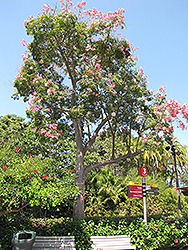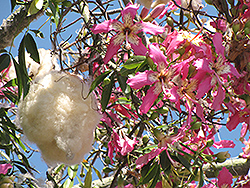It's all about ...
plants

Height: 60 feet
Spread: 30 feet
Sunlight:
![]()
Hardiness Zone: 9a
Other Names: Floss Silk Tree, form. Chorisia speciosa
Description:
This is a great exotic looking tree that grows quickly and columnar when young but then slowy branches out like an umbrella; mulch the root area; the trunk is green when young and slowly ages to grey; flowers after leaves drop in autumn; a stunning tree
Ornamental Features
Silk Floss Tree features showy clusters of rose star-shaped flowers with white overtones, brown eyes and dark brown spots at the ends of the branches in mid fall, which emerge from distinctive deep purple flower buds. It has attractive light green deciduous foliage. The serrated pointy palmate leaves are highly ornamental but do not develop any appreciable fall colour. It features abundant showy creamy white capsules from late fall to early winter. The spiny gray bark is extremely showy and adds significant winter interest.
Landscape Attributes
Silk Floss Tree is a deciduous tree with an upright spreading habit of growth. Its average texture blends into the landscape, but can be balanced by one or two finer or coarser trees or shrubs for an effective composition.
This is a relatively low maintenance tree, and should only be pruned after flowering to avoid removing any of the current season's flowers. It has no significant negative characteristics.
Silk Floss Tree is recommended for the following landscape applications;
- Accent
- Shade
- Vertical Accent
Planting & Growing
Silk Floss Tree will grow to be about 60 feet tall at maturity, with a spread of 30 feet. It has a high canopy with a typical clearance of 6 feet from the ground, and should not be planted underneath power lines. As it matures, the lower branches of this tree can be strategically removed to create a high enough canopy to support unobstructed human traffic underneath. It grows at a fast rate, and under ideal conditions can be expected to live for 80 years or more.
This tree should only be grown in full sunlight. It does best in average to evenly moist conditions, but will not tolerate standing water. It is not particular as to soil type or pH. It is somewhat tolerant of urban pollution. Consider applying a thick mulch around the root zone in both summer and winter to conserve soil moisture and protect it in exposed locations or colder microclimates. This species is not originally from North America.
This plant is not reliably hardy in our region, and certain restrictions may apply; contact the store for more information.


